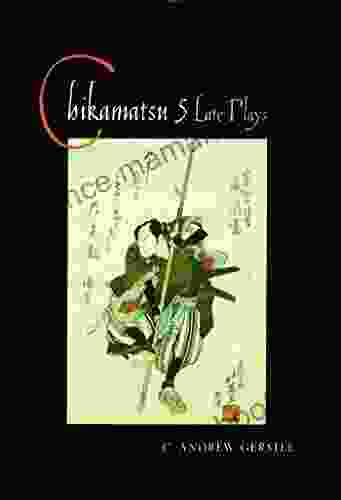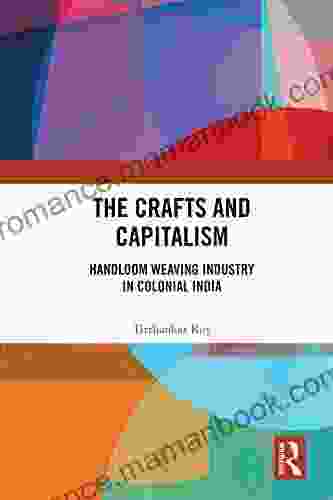Handloom Weaving Industry in Colonial India: A Comprehensive Examination of Its Decline and Revival

The handloom weaving industry in India has a long and rich history. For centuries, Indian weavers have produced exquisite textiles that have been admired around the world. However, the industry faced a serious decline during the colonial period. This decline was caused by a number of factors, including the of British power looms, the imposition of tariffs on Indian textiles, and the decline of traditional patronage.
The of British power looms in the 19th century was a major blow to the handloom weaving industry. These machines could produce cloth much faster and more cheaply than handlooms, and as a result, many weavers were forced out of business.
5 out of 5
| Language | : | English |
| File size | : | 6084 KB |
| Text-to-Speech | : | Enabled |
| Enhanced typesetting | : | Enabled |
| Word Wise | : | Enabled |
| Print length | : | 200 pages |
The imposition of tariffs on Indian textiles was another factor that contributed to the decline of the handloom weaving industry. These tariffs made it difficult for Indian weavers to compete with British manufacturers, and as a result, many weavers lost their livelihoods.
The decline of traditional patronage was another factor that contributed to the decline of the handloom weaving industry. In the past, Indian weavers had been supported by wealthy patrons who would commission them to produce textiles for their own use. However, with the rise of British power, these patrons began to favor British-made textiles, and as a result, many weavers lost their source of income.
The decline of the handloom weaving industry had a devastating impact on the Indian economy. It led to the loss of jobs, the decline of rural incomes, and the increase in poverty.
In the post-colonial period, the Indian government has taken steps to revive the handloom weaving industry. These steps include providing financial assistance to weavers, promoting the use of handloom products, and encouraging the development of new designs.
As a result of these efforts, the handloom weaving industry has begun to revive. However, the industry still faces a number of challenges, including the competition from power looms, the lack of access to finance, and the lack of skilled weavers.
Despite these challenges, the handloom weaving industry continues to play an important role in the Indian economy. It provides employment for millions of people, and it helps to preserve India's rich textile heritage.
The Impact of British Colonialism on the Handloom Weaving Industry
The British colonization of India had a profound impact on the handloom weaving industry. The of British power looms, the imposition of tariffs on Indian textiles, and the decline of traditional patronage all contributed to the decline of the industry.
The of British power looms in the 19th century was a major blow to the handloom weaving industry. These machines could produce cloth much faster and more cheaply than handlooms, and as a result, many weavers were forced out of business.
The imposition of tariffs on Indian textiles was another factor that contributed to the decline of the handloom weaving industry. These tariffs made it difficult for Indian weavers to compete with British manufacturers, and as a result, many weavers lost their livelihoods.
The decline of traditional patronage was another factor that contributed to the decline of the handloom weaving industry. In the past, Indian weavers had been supported by wealthy patrons who would commission them to produce textiles for their own use. However, with the rise of British power, these patrons began to favor British-made textiles, and as a result, many weavers lost their source of income.
The decline of the handloom weaving industry had a devastating impact on the Indian economy. It led to the loss of jobs, the decline of rural incomes, and the increase in poverty.
The Revival of the Handloom Weaving Industry
In the post-colonial period, the Indian government has taken steps to revive the handloom weaving industry. These steps include providing financial assistance to weavers, promoting the use of handloom products, and encouraging the development of new designs.
As a result of these efforts, the handloom weaving industry has begun to revive. However, the industry still faces a number of challenges, including the competition from power looms, the lack of access to finance, and the lack of skilled weavers.
Despite these challenges, the handloom weaving industry continues to play an important role in the Indian economy. It provides employment for millions of people, and it helps to preserve India's rich textile heritage.
The handloom weaving industry in India has a long and rich history. However, the industry faced a serious decline during the colonial period. This decline was caused by a number of factors, including the of British power looms, the imposition of tariffs on Indian textiles, and the decline of traditional patronage.
In the post-colonial period, the Indian government has taken steps to revive the handloom weaving industry. These steps include providing financial assistance to weavers, promoting the use of handloom products, and encouraging the development of new designs.
As a result of these efforts, the handloom weaving industry has begun to revive. However, the industry still faces a number of challenges, including the competition from power looms, the lack of access to finance, and the lack of skilled weavers.
Despite these challenges, the handloom weaving industry continues to play an important role in the Indian economy. It provides employment for millions of people, and it helps to preserve India's rich textile heritage.

5 out of 5
| Language | : | English |
| File size | : | 6084 KB |
| Text-to-Speech | : | Enabled |
| Enhanced typesetting | : | Enabled |
| Word Wise | : | Enabled |
| Print length | : | 200 pages |
Do you want to contribute by writing guest posts on this blog?
Please contact us and send us a resume of previous articles that you have written.
 Top Book
Top Book Novel
Novel Fiction
Fiction Nonfiction
Nonfiction Literature
Literature Paperback
Paperback Hardcover
Hardcover E-book
E-book Audiobook
Audiobook Bestseller
Bestseller Classic
Classic Mystery
Mystery Thriller
Thriller Romance
Romance Fantasy
Fantasy Science Fiction
Science Fiction Biography
Biography Memoir
Memoir Autobiography
Autobiography Poetry
Poetry Drama
Drama Historical Fiction
Historical Fiction Self-help
Self-help Young Adult
Young Adult Childrens Books
Childrens Books Graphic Novel
Graphic Novel Anthology
Anthology Series
Series Encyclopedia
Encyclopedia Reference
Reference Guidebook
Guidebook Textbook
Textbook Workbook
Workbook Journal
Journal Diary
Diary Manuscript
Manuscript Folio
Folio Pulp Fiction
Pulp Fiction Short Stories
Short Stories Fairy Tales
Fairy Tales Fables
Fables Mythology
Mythology Philosophy
Philosophy Religion
Religion Spirituality
Spirituality Essays
Essays Critique
Critique Commentary
Commentary Glossary
Glossary Bibliography
Bibliography Index
Index Table of Contents
Table of Contents Preface
Preface Introduction
Introduction Foreword
Foreword Afterword
Afterword Appendices
Appendices Annotations
Annotations Footnotes
Footnotes Epilogue
Epilogue Prologue
Prologue Philippa Gregory
Philippa Gregory Homura Kawamoto
Homura Kawamoto Shauna Herrington
Shauna Herrington Lisa M Bolt Simons
Lisa M Bolt Simons Mike Senior
Mike Senior Stephen Guise
Stephen Guise Shifio S Patterns
Shifio S Patterns Mo Asif
Mo Asif D Sean
D Sean Edward L Zuckerman
Edward L Zuckerman Tilly Wallace
Tilly Wallace John Heilemann
John Heilemann Dale Andrew White
Dale Andrew White William D Arand
William D Arand Curtis J Badger
Curtis J Badger Donna Tartt
Donna Tartt Lawrence Raab
Lawrence Raab Simon Spurrier
Simon Spurrier Lena Empyema
Lena Empyema Lorelei M Hart
Lorelei M Hart
Light bulbAdvertise smarter! Our strategic ad space ensures maximum exposure. Reserve your spot today!

 Chadwick PowellFive Late Plays Translations From the Asian Classics: Uncovering Hidden Gems...
Chadwick PowellFive Late Plays Translations From the Asian Classics: Uncovering Hidden Gems...
 Hamilton BellUnraveling the Secrets and Tensions of Coast Guard Recon: A Gripping Romantic...
Hamilton BellUnraveling the Secrets and Tensions of Coast Guard Recon: A Gripping Romantic...
 Arthur C. ClarkeHer Undercover Boss Billionaire: A Captivating Office Romance with a Long...
Arthur C. ClarkeHer Undercover Boss Billionaire: A Captivating Office Romance with a Long... Christian CarterFollow ·6.7k
Christian CarterFollow ·6.7k Esteban CoxFollow ·15.6k
Esteban CoxFollow ·15.6k Chance FosterFollow ·16.9k
Chance FosterFollow ·16.9k Darren NelsonFollow ·2.9k
Darren NelsonFollow ·2.9k Joseph ConradFollow ·2.7k
Joseph ConradFollow ·2.7k Foster HayesFollow ·7.2k
Foster HayesFollow ·7.2k Anthony BurgessFollow ·13.2k
Anthony BurgessFollow ·13.2k Ian McEwanFollow ·5.5k
Ian McEwanFollow ·5.5k

 Jared Nelson
Jared NelsonThe Da Vinci Code: A Literary Odyssey into the World of...
A captivating image of The Da Vinci Code...

 Harvey Bell
Harvey BellJohn Pearce: An Action-Packed Maritime Adventure
Join John...

 Ken Follett
Ken FollettSky Dragons: Unveiling the Majestic Creatures from the...
In the ethereal world of Anne McCaffrey's...

 Blake Bell
Blake BellEasy And Delicious Baking Recipes You Can Effortlessly...
Baking can be a great way to relax and...

 Maurice Parker
Maurice ParkerUnveiling the Profound Insights and Lyrical Beauty of...
In the realm of contemporary poetry, "Growl...
5 out of 5
| Language | : | English |
| File size | : | 6084 KB |
| Text-to-Speech | : | Enabled |
| Enhanced typesetting | : | Enabled |
| Word Wise | : | Enabled |
| Print length | : | 200 pages |








